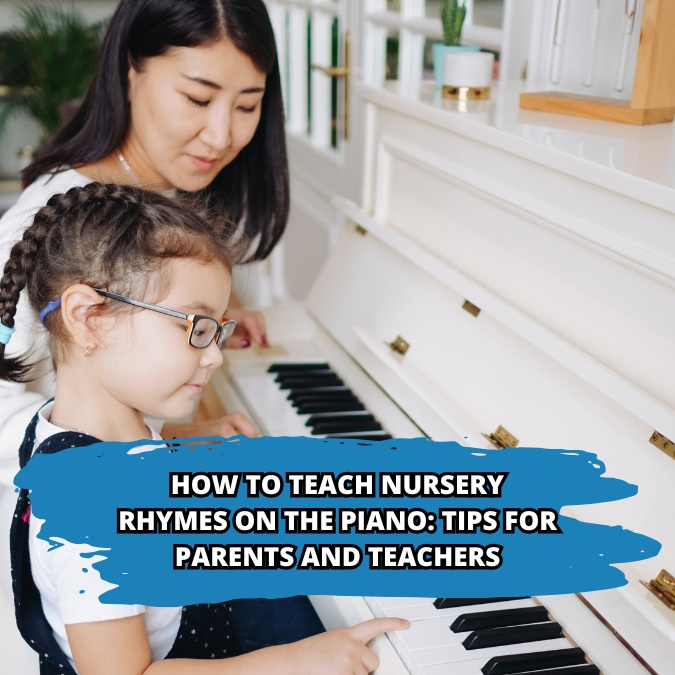How to Teach Nursery Rhymes on the Piano: Tips for Parents and Teachers

Why Nursery Rhymes Are Perfect for Piano Beginners
Simple Melodies for Easy Learning
Nursery rhymes on the piano are ideal for beginners because their melodies are simple and repetitive. These easy-to-follow tunes help learners grasp basic musical concepts without feeling overwhelmed. The repetitive nature reinforces memory, making it easier for students to recall the notes and play fluently. This simplicity encourages learners to practice regularly, building their confidence.
Building Confidence and Enjoyment
Teaching nursery rhymes on the piano helps beginners feel a sense of accomplishment early in their learning journey. As these songs are often familiar, students find joy in recognizing the melodies they create. Playing well-known nursery rhymes motivates learners to practice more, as they see quick progress. The familiar tunes create a fun and engaging environment, which fosters a love for music.
Preparing to Teach Nursery Rhymes on the Piano
Choosing the Right Piano or Keyboard
For beginners learning nursery rhymes on the piano, having a suitable instrument is crucial. A full-sized keyboard with weighted keys can help learners develop proper finger strength. However, compact keyboards are also a great option for children or those with limited space. Ensure the instrument is in good working condition to avoid unnecessary frustration during practice sessions.
Setting Up a Comfortable Learning Environment
A quiet, well-lit space is essential for effective piano learning. Adjust the piano bench height so the learner can sit comfortably with their arms at a natural angle. Ensure the learning environment is free from distractions to help the student focus on mastering nursery rhymes on the piano. A positive and organized setup can significantly impact a beginner’s motivation and success.
Selecting Beginner-Friendly Nursery Rhymes
When choosing nursery rhymes on the piano, start with well-known songs that have simple melodies. Classics like “Twinkle Twinkle Little Star” and “Mary Had a Little Lamb” are excellent options. Look for songs with fewer hand movements to make learning less intimidating. Gradually introducing slightly more challenging pieces helps maintain the learner’s interest and encourages growth.
Step-by-Step Teaching Process
Introducing the Basics: Notes and Keys
Begin teaching nursery rhymes on the piano by familiarizing learners with the keyboard layout. Explain the white and black keys and their relationship to musical notes. Use visual aids or stickers to help beginners identify keys more easily. This foundational knowledge makes playing nursery rhymes simpler and builds essential piano skills.
Breaking Down the Melody into Manageable Sections
Divide the nursery rhyme into smaller segments to make learning more manageable. Focus on one line of the melody at a time, allowing the student to master it before moving on. Encourage repetition of each section until it feels natural. Gradually combining these segments helps learners piece together the full song with confidence.
Practicing with One Hand Before Adding the Other
For beginners, starting with one hand makes it easier to learn nursery rhymes on the piano. Teach the melody with the right hand before introducing the left hand for accompaniment. This approach minimizes frustration and ensures the learner understands each part. Adding the second hand gradually helps students develop coordination and rhythm.
Teaching Rhythm and Timing Through Repetition
Use a metronome or count aloud to help beginners maintain the correct timing. Repetition is key to mastering rhythm when playing nursery rhymes on the piano. Encourage students to play slowly and focus on accuracy before increasing speed. Consistent practice helps build muscle memory and reinforces proper timing.
Tips for Keeping the Learning Process Fun
Incorporating Singing While Playing
Encourage learners to sing along while playing nursery rhymes on the piano. Singing helps reinforce the melody and timing, making it easier to play smoothly. This approach also adds an element of fun, particularly for children. Combining singing with playing fosters a deeper connection to the music.
Using Color-Coded Notes or Stickers
Color-coded notes or stickers on the keyboard can make learning nursery rhymes on the piano more accessible. Assigning colors to specific keys helps beginners quickly identify them during practice. This visual aid is especially useful for younger learners who may not yet understand musical notation. Over time, students can transition to playing without the stickers as their confidence grows.
Rewarding Progress with Small Achievements
Celebrate milestones like mastering a line or completing a full song. Rewards such as stickers, praise, or extra playtime can motivate learners to continue practicing nursery rhymes on the piano. Positive reinforcement builds confidence and encourages consistent effort. Making progress visible helps learners see their improvement over time.
Common Challenges and How to Overcome Them
Managing Short Attention Spans
Young learners may struggle with focus, especially during longer practice sessions. To overcome this, keep lessons short and engaging by breaking them into smaller activities. Incorporate fun elements, such as games or rewards, to maintain interest. Alternating between playing and listening exercises can also help keep students attentive.
Addressing Frustration and Encouraging Patience
Learning nursery rhymes on the piano can be challenging at first, leading to frustration. Remind learners that mistakes are part of the process and encourage them to try again. Offer positive feedback and highlight their progress to boost morale. Teaching patience and perseverance is an essential part of music education.
Balancing Fun and Structure in Lessons
While lessons should be enjoyable, maintaining a clear structure is important for effective learning. Set specific goals for each session to keep learners focused. At the same time, allow room for creativity and fun activities related to nursery rhymes on the piano. Striking this balance helps learners stay engaged while progressing steadily.
Recommended Nursery Rhymes to Start With
“Twinkle Twinkle Little Star”
This classic nursery rhyme is perfect for beginners due to its simple and repetitive melody. The straightforward notes help learners build confidence quickly. Playing “Twinkle Twinkle Little Star” on the piano also introduces basic hand coordination. It’s a timeless piece that brings joy to learners of all ages.
“Mary Had a Little Lamb”
Another beginner-friendly nursery rhyme, “Mary Had a Little Lamb” features a melody that’s easy to remember. Its simple note progression makes it a great introduction to playing melodies on the piano. This song helps learners practice rhythm and timing while enjoying a familiar tune. It’s an excellent choice for building foundational skills.
“Row, Row, Row Your Boat”
This nursery rhyme’s playful melody is perfect for beginners looking to learn piano. The repetitive tune reinforces note recognition and builds confidence. “Row, Row, Row Your Boat” also introduces basic rhythm patterns that are easy to grasp. Its cheerful melody makes it a favorite among young learners.
Conclusion: The Joy of Learning Nursery Rhymes on the Piano
Inspiring Lifelong Musical Interest
Playing nursery rhymes on the piano can spark a lifelong love of music in learners. These familiar tunes build confidence and encourage regular practice, creating a strong foundation for future skills. Starting with nursery rhymes allows students to experience the joy of creating music from the very beginning.
Strengthening Bonds Through Shared Musical Moments
Teaching nursery rhymes on the piano is a wonderful way for parents and teachers to connect with learners. Sharing the joy of music fosters a deeper bond and creates lasting memories. Collaborative learning experiences encourage a supportive environment, enriching the learning process for everyone involved.
FAQ
Q: What are the easiest nursery rhymes to learn on the piano?
A: “Twinkle Twinkle Little Star,” “Mary Had a Little Lamb,” and “Row, Row, Row Your Boat” are among the easiest nursery rhymes to learn on the piano. Their simple melodies and repetitive patterns make them ideal for beginners.
Q: How can I make learning nursery rhymes fun for kids?
A: You can make learning fun by incorporating singing, using color-coded keys, and celebrating small achievements. Keeping lessons engaging and interactive helps maintain their interest.
Q: How long does it take to learn a nursery rhyme on the piano?
A: It depends on the learner’s age and experience, but most beginners can learn a simple nursery rhyme in a few days to a week with consistent practice.
Q: Do I need a full-sized piano to teach nursery rhymes?
A: No, a full-sized piano is not necessary. A smaller keyboard with at least 61 keys can work well for learning nursery rhymes, especially for young beginners.
Q: What skills can beginners develop by playing nursery rhymes on the piano?
A: Playing nursery rhymes helps beginners develop skills such as hand coordination, rhythm, note recognition, and timing. These foundational skills are essential for more advanced piano learning in the future.


